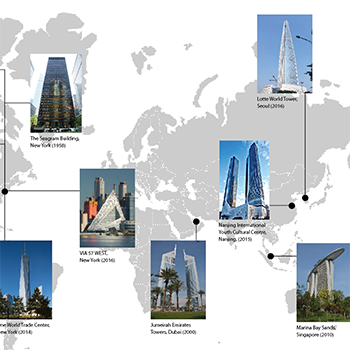Filter by
You must be a CTBUH Member to view this resource.
Jumeirah Nanjing Hotel & International Youth Cultural Centre Tower 2
Jumeirah Nanjing, Nanjing International Youth Center Tower 2
Building
Completed, 2015
210019
hotel / office
composite
315.0 m / 1,033 ft
67
3
19
120,000 m² / 1,291,669 ft²
You must be a CTBUH Member to view this resource.
You must be a CTBUH Member to view this resource.
Construction Start
Completed
Usually involved in the front end design, with a "typical" condition being that of a leadership role through either Schematic Design or Design Development, and then a monitoring role through the CD and CA phases.
Other Consultant refers to other organizations which provided significant consultation services for a building project (e.g. wind consultants, environmental consultants, fire and life safety consultants, etc).
Material Supplier refers to organizations which supplied significant systems/materials for a building project (e.g. elevator suppliers, facade suppliers, etc).
You must be a CTBUH Member to view this resource.
Usually involved in the front end design, with a "typical" condition being that of a leadership role through either Schematic Design or Design Development, and then a monitoring role through the CD and CA phases.
The Design Engineer is usually involved in the front end design, typically taking the leadership role in the Schematic Design and Design Development, and then a monitoring role through the CD and CA phases.
The Design Engineer is usually involved in the front end design, typically taking the leadership role in the Schematic Design and Design Development, and then a monitoring role through the CD and CA phases.
The main contractor is the supervisory contractor of all construction work on a project, management of sub-contractors and vendors, etc. May be referred to as "Construction Manager," however, for consistency CTBUH uses the term "Main Contractor" exclusively.
Other Consultant refers to other organizations which provided significant consultation services for a building project (e.g. wind consultants, environmental consultants, fire and life safety consultants, etc).
These are firms that consult on the design of a building's façade. May often be referred to as "Cladding," "Envelope," "Exterior Wall," or "Curtain Wall" Consultant, however, for consistency CTBUH uses the term "Façade Consultant" exclusively.
Material Supplier refers to organizations which supplied significant systems/materials for a building project (e.g. elevator suppliers, facade suppliers, etc).
CTBUH Releases Year in Review: Tall Trends of 2015
19 January 2016 - CTBUH Journal
Nanjing Regional Tour Report
20 September 2014 - Event
Tim__Griffith.jpg)
25 April 2019
Best Tall Buildings 2019: Dominant Trends
CTBUH
This year, CTBUH has vastly expanded its Awards program to consider the Best Tall Building category through several classes of height, rather than geographic regions,...
Jumeirah Nanjing Hotel & International Youth Cultural Centre Tower 2 was designed as a complex providing a grand visual termination to the central axis of an emerging central business district positioned along the banks of the Yangtze River. The complex rises as twin towers of varying heights from a shared podium containing a large conference center and concert hall which was opened in 2014 for the Youth Olympic Games held in Nanjing during August of that year. Inside the podium, interior spaces are sculpted with a fluid design theme that is reinforced with lighting placed in series of diamond shaped openings of various sizes and repeated throughout the structure. This design concept is then also translated to the exterior where the podium creates a unifying architectural weave through the complex with a series of interlocking folds wrapping the buildings while also encircling an outdoor entrance and driveway as an interior courtyard.
The façade is composed of a complex mix of glass curtain wall panels, glass-fiber reinforced concrete (GFRC) and perforated aluminum panels. The facade also has a series of diamond shaped voids of varying sizes which form a pattern that turns vertically to ascend the towers and unify them with the base structure. The theme of a fluid design is also translated onto the tower exteriors as the lower floors feature a white colored weave of curved lines which then transitions into a series of straight vertical accents climbing the towers until reaching the top.
Millions of LED lights were imbedded into the façade to create an exterior light display racing along the towers in the evening hours, creating an iconic addition to the Nanjing riverfront.
Tim__Griffith.jpg)
25 April 2019
Best Tall Buildings 2019: Dominant Trends
This year, CTBUH has vastly expanded its Awards program to consider the Best Tall Building category through several classes of height, rather than geographic regions,...

08 August 2017
Ten Significant Tall Buildings, and the Significant Women Behind Them
Recently, there has been a growing and overdue recognition in the architecture discipline that women are under-represented, not just in terms of leadership positions held,...

01 January 2017
International Youth Cultural Centre, Nanjing, China
Located in the west of Nanjing Jianye Business District along the banks of the Yangtze River, the Nanjing International Youth Cultural Centre development rises as...
Ermell_ccbysa.jpg)
19 January 2016
Year in Review: Tall Trends of 2015
CTBUH has determined that 106 buildings of 200 meters’ height or greater were completed around the world in 2015 – setting a new record for...
19 January 2016
CTBUH has determined that 106 buildings of 200 meters’ height or greater were completed around the world in 2015 – setting a new record for annual tall building completions.
Subscribe below to receive periodic updates from CTBUH on the latest Tall Building and Urban news and CTBUH initiatives, including our monthly newsletter. Fields with a red asterisk (*) next to them are required.
View our privacy policy